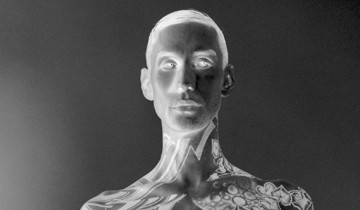Andreas Fux
SPACE BOY
November 11, 2017 – December 23, 2017
It’s not a coincidence that for this experiment the artist chose the image of a tattooed model. Every image is per se the display of a surface. Andreas Fux duplicates this principle. He has a preference for images of surfaces that display other images. The body surface of his model obtains a new material presence in form of a carpet, whereby the pattern that traditionally decorates and structures the carpet is located on the human body which so constitutes the actual motive. The body begins–much more than in a photograph–to shimmer by its millions of threats between naturalistic presentation and ornamentation. Similarly ambivalent is the play between carpet and image, between object and presentation. Andreas Fux has deliberately moved the motive to the right in order to avoid a complete symmetry, which usually emphasises the ornamental aspect.
To stress the play with layers of reception Andreas Fux modified the original image to appear like an old glass negativ: black and white but depending on the light dazzling with a hardly tangible abundance of colouration. This effect is transformed in the pile made of pure silk which changes its appearance depending on the angle of light incidence. Moreover what appears to be a black and white motive is actually a color image. The knots consist of 18 different colours which create an abundance of shades.
The carpet was manufactured in Jaipur, the capital of the North Indian province Rajasthan. Four to five carpet makers worked simultaneously for about three thousand hours to complete this master piece. However, such an undertaking is always a bit of an adventure. Despite all the experience of the manufacturer the effect of such a motive is only apparent when the process is completed. It is more than just a transmission of an image to another surface. A sense of discreetness is useful and so the determination to use a black and white photograph as a motive turned out to be a success.
Andreas Fux lives and works in Berlin. His first works were published in 1988 by ‘Das Magazin’, a monthly East Berlin magazine. He operates since 1990 independently for various magazines and newspapers. Andreas Fux belongs to that artist group from Prenzlauerberg that documents the last decade of the GDR, the political change after the fall and the transition to the FRG. So far three artist’s books have been published. The latest book ‘Fährten’ is on stock and available at the gallery.
To stress the play with layers of reception Andreas Fux modified the original image to appear like an old glass negativ: black and white but depending on the light dazzling with a hardly tangible abundance of colouration. This effect is transformed in the pile made of pure silk which changes its appearance depending on the angle of light incidence. Moreover what appears to be a black and white motive is actually a color image. The knots consist of 18 different colours which create an abundance of shades.
The carpet was manufactured in Jaipur, the capital of the North Indian province Rajasthan. Four to five carpet makers worked simultaneously for about three thousand hours to complete this master piece. However, such an undertaking is always a bit of an adventure. Despite all the experience of the manufacturer the effect of such a motive is only apparent when the process is completed. It is more than just a transmission of an image to another surface. A sense of discreetness is useful and so the determination to use a black and white photograph as a motive turned out to be a success.
Andreas Fux lives and works in Berlin. His first works were published in 1988 by ‘Das Magazin’, a monthly East Berlin magazine. He operates since 1990 independently for various magazines and newspapers. Andreas Fux belongs to that artist group from Prenzlauerberg that documents the last decade of the GDR, the political change after the fall and the transition to the FRG. So far three artist’s books have been published. The latest book ‘Fährten’ is on stock and available at the gallery.

Exhibition
November 11 – December 23, 2017
Opening reception:
Saturday, November 11, 2017, 3–8 pm
3 pm
Opening reception
4 pm
Welcome address and Hot Dogs
6 pm
Exhibition tour
Sunday, November 12, 2017, 11 am–4 pm
Long weekend:
Saturday, December 2, 2017, 11 am–9 pm
Sunday, December 3, 2017, 11 am–4 pm
Opening hours:
Wednesday, Thursday, Friday 2–6 pm
Saturday 11 am–4 pm
and by appointment
Opening reception:
Saturday, November 11, 2017, 3–8 pm
3 pm
Opening reception
4 pm
Welcome address and Hot Dogs
6 pm
Exhibition tour
Sunday, November 12, 2017, 11 am–4 pm
Long weekend:
Saturday, December 2, 2017, 11 am–9 pm
Sunday, December 3, 2017, 11 am–4 pm
Opening hours:
Wednesday, Thursday, Friday 2–6 pm
Saturday 11 am–4 pm
and by appointment
